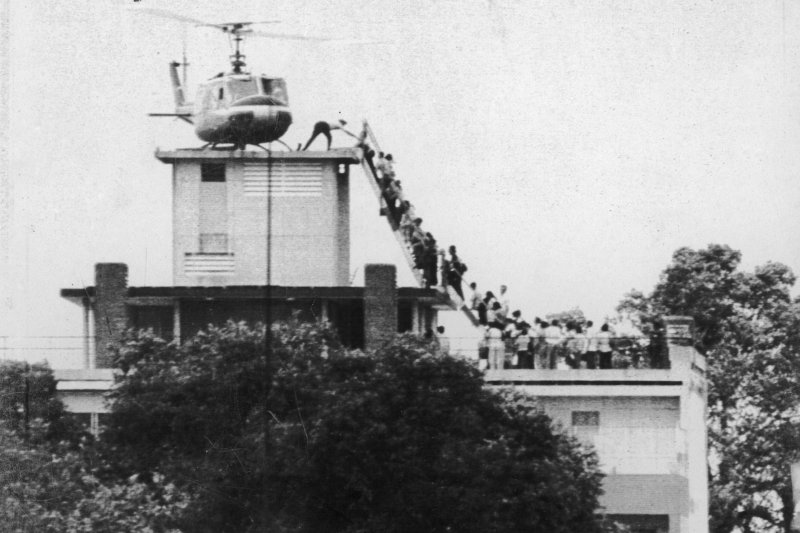An Air America helicopter crew member helps evacuees up a ladder on the roof of 18 Gia Long Street April 29, 1975 shortly before the city of Saigon fell to advancing North Vietnamese troops. Photo by Hugh Van Es/UPI |
License Photo
SAIGON, April 29, 1975 (UPI) - The United States pulled out of South Vietnam today and Saigon Government sources said the South Vietnam administration and the Viet Cong had reached agreement in principle on a ceasefire.
The American evacuation, on orders of Vietnamese President Duong Van (Big) Minh, set up the surrender of Saigon to the Communists, ending 30 years of warfare in Indochina and 14 years of American involvement.
U.S. Marine helicopters plucked groups of 20 and 50 Americans, other foreigners and some Vietnamese from landing pads at Tan Son Nhut Airport and the U.S. Embassy as mobs of panicky Vietnamese sought flights to safety.
Two senior Saigon Government sources said new Vice President Nguyen Van Huyen had met with Viet Cong officials in Saigon today and agreed in principle on a cease-fire to begin tomorrow.
However, the Viet Cong demanded that all South Vietnamese troops be disarmed and all U.S. warships be removed from the area before a truce would be declared.
At least one of 81 helicopters used in flying out the Americans today was hit by gunfire.
Dozens of South Vietnamese aircraft, carrying soldiers and their families, flew to Taiwan, Singapore, Thailand and the Philippines. More than 70 planes with 1,700 refugees landed in Thailand. At least 10 South Vietnamese helicopters flew to U.S. ships and ditched in the ocean. All aboard were rescued.
South Vietnamese sailors began boarding ships in the Saigon River to flee the battle zone. At one point they opened fire on South Vietnamese civilians attempting to join them.
Frightened South Vietnamese pushed some Americans off buses sent to take them to Tan Son Nhut Airport to be flown out on U.S. helicopters. South Vietnamese troops opened fire on the buses. No injuries were reported. But earlier two U.S. marines were killed when the communists shelled the airport.
The dead marines were identified as Cpl. Charles McMahon Jr. of Woburn, Mass., and Lance Cpl. Darwin L. Judge of Marshalltown, Iowa.
Fires around Saigon lit the night sky as the huge American helicopters, protected by Navy F4 Phantom and Marine Cobra helicopter gunships, continued the evacuation.
There was no let-up in the helicopter shuttles which began at 3:30 p.m. (3:30 a.m. Eastern time).
The helicopters carried the evacuees to more than 50 Seventh Fleet warships off Vietnam.
The American withdrawal caused some panic, but less than many analysts had expected. A 24-hour curfew kept most Saigon residents off the streets.
The U.S. Defense Department said that as of 6:30 a.m. Eastern time, 4,000 persons had been removed from Saigon. It said operations were almost complete except for removal of Marine guards brought in from ships in the South China Sea.
Those removed included 950 Americans; the rest were South Vietnamese.
Navy fighter-bombers protected the CH53 Jolly Green Giant choppers, each carrying about 50 Americans, but there was little or no armed opposition to the U.S. departure. The Viet Cong appeared to have pulled back to facilitate the departure of the Americans, but mortar shells hit Tan Son Nhut Airport during the day, menacing the airlift.
At one point U.S. Navy Phantom jets fired on a Communist antiaircraft battery that had fired on them.
The helicopters took off into skies filled with thunderclouds and headed southeast toward the coast.
A crowd of Vietnamese, some angry, some frightened, pushed against the gates of the U.S. Embassy as U.S. Marines were landed by helicopters inside the walled compound. Marine reinforcements kept the crowd outside the compound to prevent the mob scenes that marked the flight from Da Nang.
Several dozen Americans were trapped on high buildings around the city before they were plucked off by helicopters.
There was no evidence of a direct Viet Cong attack on the city but explosions could be heard in the distance. There were reports that South Vietnamese Navy personnel fired on South Vietnamese civilians while trying to get to their ships to leave Saigon.
It appeared that many of the South Vietnamese armed forces were fleeing and that Saigon would be surrendered without a fight.
The new South Vietnamese Government headed by Gen. Minh said he ordered the Americans to leave within 24 hours to meet a Viet Cong demand for the start of peace talks.















